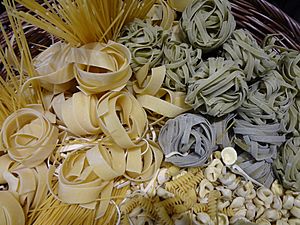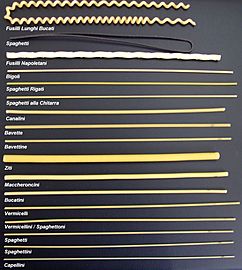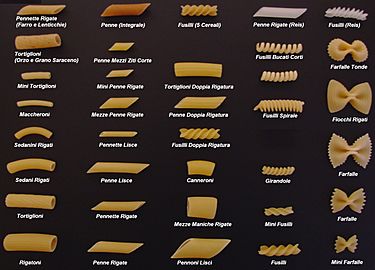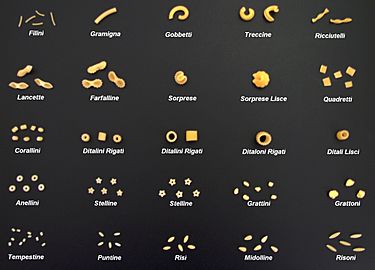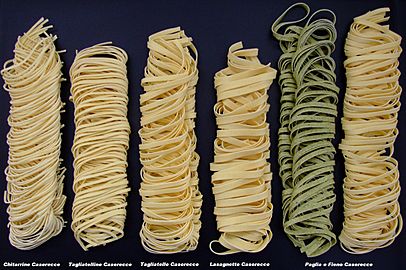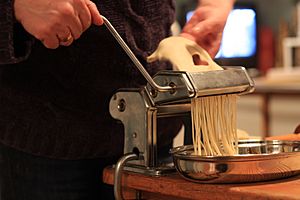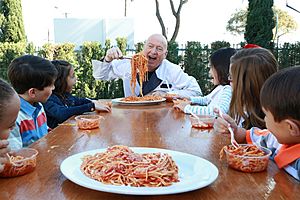Pasta facts for kids
|
A child eating pasta
|
|
| Type | Staple ingredient for many dishes |
|---|---|
| Place of origin | Italy |
| Main ingredients | Durum wheat flour |
| Ingredients generally used | Water, eggs |
| Variations | Rice flour pasta, Legume pasta |
Pasta is a staple food of Italian cuisine. Pasta is typically made from an unleavened dough of durum wheat flour mixed with water or eggs, and formed into sheets or various shapes, then cooked by boiling or baking. Rice flour, or legumes, such as beans or lentils are sometimes used in place of wheat flour to yield a different taste and texture, or as a gluten-free alternative.
Pastas are divided into two broad categories: dried and fresh. Most dried pasta is produced commercially via an extrusion process, although it can be produced at home. Fresh pasta is traditionally produced by hand, sometimes with the aid of simple machines. Fresh pastas available in grocery stores are produced commercially by large-scale machines.
Both dried and fresh pastas come in a number of shapes and varieties, with 310 specific forms known by over 1300 documented names. In Italy, the names of specific pasta shapes or types often vary by locale. For example, the pasta form cavatelli is known by 28 different names depending upon the town and region. Common forms of pasta include long and short shapes, tubes, flat shapes or sheets, miniature shapes for soup, those meant to be filled or stuffed, and specialty or decorative shapes.
Pasta dishes are generally simple, but individual dishes vary in preparation. Some pasta dishes are served as a small first course or for light lunches, such as pasta salads. Other dishes may be portioned larger and used for dinner. Pasta sauces similarly may vary in taste, color and texture.
In terms of nutrition, cooked plain pasta is 31% carbohydrates (mostly starch), 6% protein, and low in fat, with moderate amounts of manganese, but pasta generally has low micronutrient content. Pasta may be enriched or fortified, or made from whole grains.
Contents
Etymology
First attested in English in 1874, the word "pasta" comes from Italian pasta, in turn from Latin pasta, latinisation of the Greek παστά (pasta) "barley porridge".
History

In the 1st century AD writings of Horace, lagana (singular: laganum) were fine sheets of fried dough and were an everyday foodstuff. Writing in the 2nd century Athenaeus of Naucratis provides a recipe for lagana which he attributes to the 1st century Chrysippus of Tyana: sheets of dough made of wheat flour and the juice of crushed lettuce, then flavoured with spices and deep-fried in oil. An early 5th century cookbook describes a dish called lagana that consisted of layers of dough with meat stuffing, an ancestor of modern-day lasagna. However, the method of cooking these sheets of dough does not correspond to our modern definition of either a fresh or dry pasta product, which only had similar basic ingredients and perhaps the shape. The first concrete information concerning pasta products in Italy dates from the 13th or 14th century.
Historians have noted several lexical milestones relevant to pasta, none of which changes these basic characteristics. For example, the works of the 2nd century AD Greek physician Galen mention itrion, homogeneous compounds made of flour and water. The Jerusalem Talmud records that itrium, a kind of boiled dough, was common in Palestine from the 3rd to 5th centuries AD. A dictionary compiled by the 9th century Arab physician and lexicographer Isho bar Ali defines itriyya, the Arabic cognate, as string-like shapes made of semolina and dried before cooking. The geographical text of Muhammad al-Idrisi, compiled for the Norman King of Sicily Roger II in 1154 mentions itriyya manufactured and exported from Norman Sicily:
West of Termini there is a delightful settlement called Trabia. Its ever-flowing streams propel a number of mills. Here there are huge buildings in the countryside where they make vast quantities of itriyya which is exported everywhere: to Calabria, to Muslim and Christian countries. Very many shiploads are sent.
One form of itriyya with a long history is laganum (plural lagana), which in Latin refers to a thin sheet of dough, and gives rise to Italian lasagna.
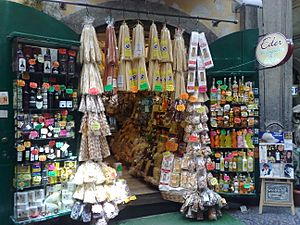
In North Africa, a food similar to pasta, known as couscous, has been eaten for centuries. However, it lacks the distinguishing malleable nature of pasta, couscous being more akin to droplets of dough. At first, dry pasta was a luxury item in Italy because of high labor costs; durum wheat semolina had to be kneaded for a long time.
There is a legend of Marco Polo importing pasta from China which originated with the Macaroni Journal, published by an association of food industries with the goal of promoting pasta in the United States. Rustichello da Pisa writes in his Travels that Marco Polo described a food similar to "lagana". Jeffrey Steingarten asserts that Arabs introduced pasta in the Emirate of Sicily in the ninth century, mentioning also that traces of pasta have been found in ancient Greece and that Jane Grigson believed the Marco Polo story to have originated in the 1920s or 30s in an advertisement for a Canadian spaghetti company.
In Greek mythology, it is believed that the god Hephaestus invented a device that made strings of dough. This was the earliest reference to a pasta maker.
In the 14th and 15th centuries, dried pasta became popular for its easy storage. This allowed people to store pasta on ships when exploring the New World. A century later, pasta was present around the globe during the voyages of discovery.
Although tomatoes were introduced to Italy in the 16th century and incorporated in Italian cuisine in the 17th century, description of the first Italian tomato sauces dates from the late 18th century: the first written record of pasta with tomato sauce can be found in the 1790 cookbook L'Apicio Moderno by Roman chef Francesco Leonardi. Before tomato sauce was introduced, pasta was eaten dry with the fingers; the liquid sauce demanded the use of a fork.
History of manufacturing
At the beginning of the 17th century, Naples had rudimentary machines for producing pasta, later establishing the kneading machine and press, making pasta manufacturing cost-effective. In 1740, a license for the first pasta factory was issued in Venice. During the 1800s, water mills and stone grinders were used to separate semolina from the bran, initiating expansion of the pasta market. In 1859, Joseph Topits (1824−1876) founded the first pasta factory of Hungary in the city of Pest, which worked with steam machines; it was one of the first pasta factories of Central Europe. By 1867, Buitoni Company in Sansepolcro, Tuscany became an established pasta manufacturer. During the early 1900s, artificial drying and extrusion processes enabled greater variety of pasta preparation and larger volumes for export, beginning a period called "The Industry of Pasta". In 1884, the Zátka Brothers’s plant in Boršov nad Vltavou was founded and this was the first Pasta factory of Bohemia.
Evolution
Using tomato sauce to give pasta its flavour was revolutionary, since it was originally eaten plain. The consumption of pasta has changed over time; while once a small, simple item, it is now often eaten in much larger portions and as part of complex, sophisticated dishes. Factors such as low prices and ease of cooking contribute to the growing popularity of this staple item.
In modern times
The art of pasta making and the devotion to the food as a whole has evolved since pasta was first conceptualized. It is estimated that Italians eat over 60 pounds (27 kg) of pasta per person, per year, easily beating Americans, who eat about 20 pounds (9.1 kg) per person. Pasta is so beloved in Italy that individual consumption exceeds the average production of wheat of the country; thus Italy frequently imports wheat for pasta making. In contemporary society pasta is ubiquitous and individuals can find a variety of types in local supermarkets. With the worldwide demand for this staple food, pasta is now largely mass-produced in factories and only a tiny proportion is crafted by hand.
Pasta was originally solely a part of Italian and European cuisine. With an increase in popularity on a worldwide scale, pasta has crossed international borders and is now a popular form of fast food and a staple in North America and elsewhere. This is due to the great amount of Italian immigration into Canada and the United States around the beginning of the 20th century. Similarly, an immense immigration of Italians into South Africa ensured that spaghetti with meatballs became an essential part of South African cuisine.
Ingredients
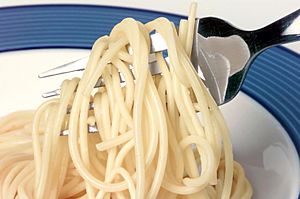
Since at least the time of Cato's De Agri Cultura, basic pasta dough has been made mostly of wheat flour or semolina, with durum wheat used predominantly in the South of Italy and soft wheat in the North. Regionally other grains have been used, including those from barley, buckwheat, rye, rice, and maize, as well as chestnut and chickpea flours.
To address needs of people affected by gluten-related disorders (such as coeliac disease, non-celiac gluten sensitivity and wheat allergy sufferers), some recipes use rice or maize for making pasta. Grain flours may also be supplemented with cooked potatoes.
Other additions to the basic flour-liquid mixture may include vegetable purees such as spinach or tomato, mushrooms, cheeses, herbs, spices and other seasonings. While pastas are, most typically, made from unleavened doughs, the use of yeast-raised doughs are also known for at least nine different pasta forms.
Additives in dried, commercially sold pasta include vitamins and minerals that are lost from the durum wheat endosperm during milling. They are added back to the semolina flour once it is ground. Micronutrients added may include niacin (vitamin B3), riboflavin (vitamin B2), folate, thiamine (vitamin B1), and ferrous iron.
Varieties
Fresh
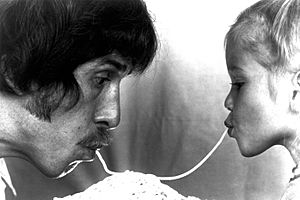
Fresh pasta is usually locally made with fresh ingredients unless it is destined to be shipped, in which case consideration is given to the spoilage rates of the desired ingredients such as eggs or herbs. Furthermore, fresh pasta is usually made with a mixture of eggs and all-purpose flour or “00” low-gluten flour. Since it contains eggs, it is more tender compared to dried pasta and only takes about half the time to cook. Delicate sauces are preferred for fresh pasta in order to let the pasta take front stage.
Fresh pastas do not expand in size after cooking; therefore, 1.5 pounds (0.68 kg) of pasta are needed to serve four people generously. Fresh egg pasta is generally cut into strands of various widths and thicknesses depending on which pasta is to be made (e.g. fettuccine, pappardelle, and lasagne). It is best served with meat, cheese, or vegetables to create ravioli, tortellini, and cannelloni. Fresh egg pasta is well known in the Piedmont region and Emilia Romagna region in North Italy. In this area, dough is only made out of egg yolk and flour resulting in a very refined flavour and texture. This pasta is often served simply with butter sauce and thinly sliced truffles that are native to this region. In other areas, such as Apulia fresh pasta can be made without eggs. The only ingredients needed to make the pasta dough are semolina flour and water, which is often shaped into orecchiette or cavatelli. Fresh pasta for cavatelli is also popular in other places including Sicily. However, the dough is prepared differently: it is made of flour and ricotta cheese instead.
Dried
Dried pasta can also be defined as factory-made pasta because it is usually produced in large amounts that require large machines with superior processing capabilities to manufacture. Dried pasta is mainly shipped over to farther locations and has a longer shelf life. The ingredients required to make dried pasta include semolina flour and water. Eggs can be added for flavour and richness, but are not needed to make dried pasta. In contrast to fresh pasta, dried pasta needs to be dried at a low temperature for several days to evaporate all the moisture allowing it to be stored for a longer period. Dried pastas are best served in hearty dishes like ragu sauces, soups, and casseroles. Once it is cooked, the dried pasta will usually grow to twice its original size. Therefore, approximately 1 pound (0.45 kg) of dried pasta serves up to four people.
Culinary uses
Pasta is generally served with some type of sauce; the sauce and the type of pasta are usually matched based on consistency and ease of eating. Northern Italian cooking uses less tomato sauce, garlic and herbs, and white sauce is more common. However Italian cuisine is best identified by individual regions. Pasta dishes with lighter use of tomato are found in Trentino-Alto Adige and Emilia Romagna. In Bologna, the meat-based Bolognese sauce incorporates a small amount of tomato concentrate and a green sauce called pesto originates from Genoa. In Central Italy, there are sauces such as tomato sauce, amatriciana, arrabbiata and the egg-based carbonara. Tomato sauces are also present in Southern Italian cuisine, where they originated. In Southern Italy more complex variations include pasta paired with fresh vegetables, olives, capers or seafood. Varieties include puttanesca, pasta alla norma (tomatoes, eggplant and fresh or baked cheese), pasta con le sarde (fresh sardines, pine nuts, fennel and olive oil), spaghetti aglio, olio e peperoncino (literally with garlic, [olive] oil and hot chili peppers).
Processing
Fresh
Ingredients to make pasta dough include semolina flour, egg, salt and water. Flour is first mounded on a flat surface and then a well in the pile of flour is created. Egg is then poured into the well and a fork is used to mix the egg and flour. There are a variety of ways to shape the sheets of pasta depending on the type required. The most popular types include penne, spaghetti, and macaroni.
Kitchen pasta machines, also called pasta makers, are popular with cooks who make large amounts of fresh pasta. The cook feeds sheets of pasta dough into the machine by hand, and by turning a hand crank, rolls the pasta to thin it incrementally. On the final pass through the pasta machine, the pasta may be directed through a machine 'comb' to shape the pasta noodles as they emerge.
Matrix and extrusion
Semolina flour consists of a protein matrix with entrapped starch granules. Upon the addition of water, during mixing, intermolecular forces allow the protein to form a more ordered structure in preparation for cooking.
Durum wheat is ground into semolina flour which is sorted by optical scanners and cleaned. Pipes allow the flour to move to a mixing machine where it is mixed with warm water by rotating blades. When the mixture is of a lumpy consistency, the mixture is pressed into sheets or extruded. Varieties of pasta such as spaghetti and linguine are cut by rotating blades while pasta such as penne and rotini are extruded. The size and shape of the dies in the extruder through which the pasta is pushed determine the shape that results. The pasta is then dried at a high temperature.
Factory-manufactured
The ingredients to make dried pasta usually include water and semolina flour; egg for colour and richness (in some types of pasta), and possibly vegetable juice (such as spinach, beet, tomato, carrot), herbs or spices for colour and flavour. After mixing semolina flour with warm water the dough is kneaded mechanically until it becomes firm and dry. If pasta is to be flavoured, eggs, vegetable juices, and herbs are added at this stage. The dough is then passed into the laminator to be flattened into sheets, then compressed by a vacuum mixer-machine to clear out air bubbles and excess water from the dough until the moisture content is reduced to 12%. Next, the dough is processed in a steamer to kill any bacteria it may contain.
The dough is then ready to be shaped into different types of pasta. Depending on the type of pasta to be made, the dough can either be cut or extruded through dies. The pasta is set in a drying tank under specific conditions of heat, moisture, and time depending on the type of pasta. The dried pasta is then packaged: Fresh pasta is sealed in a clear, airtight plastic container with a mixture of carbon dioxide and nitrogen that inhibits microbial growth and prolongs the product's shelf life; dried pastas are sealed in clear plastic or cardboard packages.
Gluten-free
Gluten, the protein found in grains such as wheat, rye, spelt, and barley, contributes to protein aggregation and firm texture of a normally cooked pasta. Gluten-free pasta is produced with wheat flour substitutes, such as vegetable powders, rice, corn, quinoa, amaranth, oats and buckwheat flours. Other possible gluten-free pasta ingredients may include hydrocolloids to improve cooking pasta with high heat resistance, xanthan gum to retain moisture during storage, or hydrothermally-treated polysaccharide mixtures to produce textures similar to those of wheat pasta.
Storage
The storage of pasta depends its processing and extent of drying. Uncooked pasta is kept dry and can sit in the cupboard for a year if airtight and stored in a cool, dry area. Cooked pasta is stored in the refrigerator for a maximum of five days in an airtight container. Adding a couple teaspoons of oil helps keep the food from sticking to itself and the container. Cooked pasta may be frozen for up to two or three months. Should the pasta be dried completely, it can be placed back in the cupboard.
Images for kids
-
A small hand-cranked pasta machine designed to sheet fresh pasta dough and cut tagliatelle
See also
 In Spanish: Pasta para niños
In Spanish: Pasta para niños



